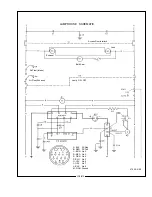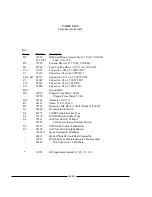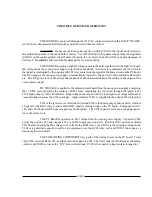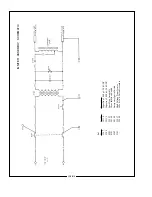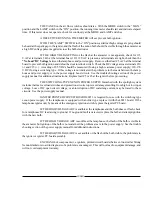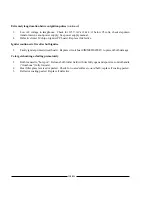
OPERATION
INSTALL THE GLASS HEAT FILTER into the bracket mounted on the rear of the fadeout
and douser support housing. NOTE: The coated side of the filter, with the XX or other marking, must be
facing the reflector. Reach through the side door and nose opening of the lamphouse, slide the filter into the slot
in the top angle bracket, and lower it into the bottom slotted bracket.
REMOVE THE PLASTIC COVER from the xenon bulb. DO NOT ignite the lamp with the
cover on the bulb. Store the cover for future re-use.
CLOSE AND SECURE the lamphouse door using the tamperproof screws and special screw-
driver supplied with the lamphouse. Engage the cam lock and install the security screw. The door must be
completely secured to actuate the interlock switch and permit lamp ignition. Place the MODE switch in the
“MAN.” (manual) position.
TURN ON THE MAIN LINE SWITCH and/or circuit breaker to energize the xenon power
supply. The lamphouse blowers will start and the blower interlock switches will be actuated to permit lamp
ignition. The blowers will operate continuously until the xenon power supply is de-energized.
PLACE THE LAMP SWITCH in the “ON” position and the lamp will ignite. If ignition does
not occur, or the high voltage pulse is not apparent, press the emergency ignition switch on the top of the
lamphouse under the plug button. Do not hold more than one second; release immediately upon lamp ignition.
Use of the emergency ignition switch indicates an abnormal condition; see the TROUBLESHOOTING section
following.
CHECK THE READING on the lamphouse ammeter. Nominal current for the 2500 watt
xenon bulb is 90 amperes. DO NOT, AT ANY TIME, exceed 100 amperes. Output current is adjusted at the
power supply; see power supply manual for instructions. Operation of a new bulb is normally started at the
lower end of its range (80 A.), and current is gradually increased as the bulb ages to maintain light output.
PRESS THE SMALL PUSH BUTTON SWITCH located below the ammeter to read the DC
voltage at the arc. This permits immediate calculation of the power at which the lamp is operating (volts x
amperes = wattage). Holding this switch in during the ignition cycle will also briefly indicate the “no load”
(open circuit) DC voltage applied to the xenon bulb for ignition.
REMOVE THE REAR COVER PLATE below the instrument panel by withdrawing the two
plastic plungers. This exposes the bulb positioning controls in the lamphouse back casting.
TO FOCUS THE XENON BULB and obtain the best light on the stage, the two methods
outlined below are the most suitable.
MOVE THE SPOT SIZE CONTROL HANDLE (trombone) on the large lens carriage all the
way forward to project the smallest spot possible; place the iris, masking shutters (choppers) and the fadeout
douser blades in their full open positions. Project a spot to a wall or similar flat perpendicular surface opposite
the spotlight position.
XG2/009
Summary of Contents for XENON GLADIATOR II
Page 2: ......
Page 27: ...1 2 3 4 5 6 7 8 9 10 11 12 13 FIGURE 1 XG2 025 ...
Page 29: ...1 2 3 4 5 6 7 8 9 10 11 12 13 14 15 16 17 18 19 FIGURE 2 XG2 027 ...
Page 32: ...1 2 3 4 5 6 7 8 9 10 11 12 13 FIGURE 3 XG2 030 ...
Page 34: ...1 2 3 4 5 6 7 8 9 10 11 12 13 14 15 FIGURE 4 XG2 032 ...
Page 36: ...1 2 3 4 5 6 7 8 9 10 FIGURE 5 IGNITER ASSEMBLY XG2 034 ...
Page 39: ...FIGURE 6 XG2 037 ...
Page 41: ...FIGURE 7 XG2 039 ...
Page 43: ...FIGURE 8 XG2 041 ...
Page 46: ...58 59 FIGURE 9 Item 58 Bracket mounts to back surface of Item 31 XG2 044 ...
Page 50: ...FIGURE 10 47 XG2 048 ...
Page 53: ......
Page 54: ......

















